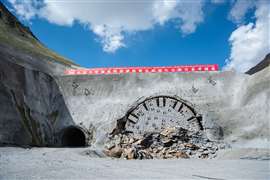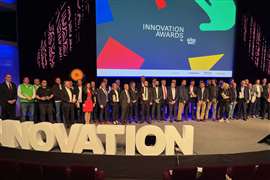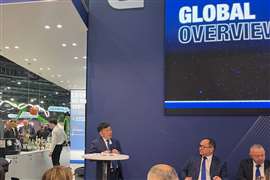Portable power solutions
12 December 2013

When it comes to portable power, contractors may just want a box where they can press the ‘start’ button and get air, electricity or light as and when they need it. It sounds like a simple requirement, but there are of course many subtle design features and considerations that make a good, fit-for-purpose compressor, generator or lighting tower. And it is not an industry that is standing still, with new demands on energy efficiency, reliability and transportability influencing the design of products coming onto the market.
A new machine that could be of interest to contractors and rental companies working internationally is the Himoinsa HRTW 1300 dual frequency generator set. The unit is designed with the idea that it could be used anywhere in the world, so as well as offering electricity – up to 1,039 kW – at either 50 Hz or 60 Hz, it can also fit into a standard 20 ft (6.1 m) shipping container.
The brief to build a generator that can work in any part of the world also means consideration has been given to the extreme temperatures the HRTW 1300 could work in. Its design features a variable speed fan to match the cooling effort to what the engine needs, and this system also cuts fuel consumption and noise. Himoinsa says the large radiator means the unit can put out its full power rating at temperatures up to 50° C.
The unit can be connected to an external fuel tank, and there is a diesel pre-filter to protect it against low quality fuel, while cleaning and maintenance should be made easier by an interior lighting system and wide folding access panels..
New from Doosan meanwhile are the G80-IIIA (80 kVA prime power) and G100-IIIA (100 kVA prime power) generators. An interesting feature is the fuel tank frame system, integrates a base to contain any fluid spills into the frame itself.
The generators have a standard fuel capacity offering a minimum of 12 hours of autonomous operation (at 75% of the load), while a 24-hour onboard fuel tank configuration is available as
an option.
Safe and easy access to operation and maintenance areas are a design feature with improvements to the accessibility to key areas. These include the centrally positioned lifting eye, engine radiator compartment and maintenance points.
A digital control panel version, offering extended parameter measurements and historical storage of events and alarms, is available as an option, and a new switchable dual frequency 50/60 Hz feature is available with the digital controller.
Emissions control
As in the wider construction equipment world, portable power systems are subject to increasingly strict rules on diesel engine exhaust emissions in Europe and the US. In the generator segment, Cummins Power Generation claims to be one of the first manufacturers to offer machines that comply with the Tier 4 Final regulations for 175 hp – 751 hp (131 kW – 560 kW) engines that come into force in the US at the start of next year.
Cummins has met the requirements of the legislation with a combination of in-cylinder engine improvements, exhaust gas recirculation (EGR) and selective catalytic reduction (SCR) exhaust aftertreatment. It said that it had achieved enough improvements in the combustion process not to need a diesel particulate filter (DPF) for further aftertreatment in the exhaust system.
“As a consequence, our new mobile rental generators are 4% to 5% more fuel efficient than previous Tier 3 models,” said Santhosh Sorab, marketing manager for Tier4 Final product development of Cummins Power Generation.
The first Tier 4 Final generator sets for the rental market from Cummins Power Generation will be the C150D2R, standby rated at 150 kW, and the C200D2R, standby rated at 200 kW. Both will be available by the third quarter of 2014.They will feature switchable 60/50Hz dual frequency operation with multiple voltage configurations of 208V, 240V and 480V in three-phase, and 240V in single-phase.
There is a clear growth trend in the genset and lighting tower business, and this is drawing new manufacturers into the sector and encouraging the incumbents to spread their wings.
JCB Power Products – the JCB division that sells generators and lighting towers – says it is poised for a major expansion of its distribution network over the coming five years, with the number of dealers expected to increase from the current 60 to nearer 240.
Jonathan Garnham, who took up the post of director and general manager of the business in January this year, said, “We’ve learned about what is required to be a successful dealer in Power Products. Globally, our dealers who have taken part have had their eyes opened to the opportunity.”
As the company plans its expansion it is also growing its product range, with new LED lighting towers being launched as well as improvements to its range of generators, which are now using new digital controllers.
JCB uses its own four-cylinder engines in around 15% to 20% of its gensets – those in the 60 to 140 kVA range – and it intends to incorporate the six-cylinder engine launched this year by the third quarter 2014, taking the JCB-powered genset range up to around 200 kVA. The full generator line comprises 114 models from 8 to 2700 kVA, all of which are built by an unnamed third party.
Hybrids
Another interesting new product for the construction industry is the ES Site Power from Energy Solutions. This has been designed to account for the issue that loads on generators vary a lot throughout the day on construction sites.
The unit is a hybrid system including both batteries and a generator. By day the generator runs as normal providing power to the site and charging the batteries. At night the generator part can be switched off, saving fuel and unnecessary engine hours, with the batteries providing enough power for the reduced requirements of the site. This also means noise is reduced at night, which can be an important consideration.
Energy Solutions’ managing director, Paul Holland said, “Overall we have seen fuel savings of 30% to 40% and an average of a one third reduction in running hours. With figures like these we know the product will be highly beneficial.”
ES Site Power is available in three power capacities all with the option of sealed maintenance-free gel batteries.
This type of hybrid approach is also finding traction in the lighting tower market. This year saw UK-based Tower Light launch its VT-Hybrid, which has a similar hybrid engine/battery system that would typically run the light for 8 hours on the generator (which also charges the battery) and then 8 hours on the battery.
This means the system is silent for half the time and Tower Light says fuel usage is so low that it can run for more than 500 hours on a single tank of fuel.
The company estimates this can reduce costs by some UK£ 400 (US$ 650) per month and save over 1 tonne of CO² emissions when using a VT-Hybrid instead of a traditional lighting tower.
Taking the concept even further, UK-based OnGarde now offers a portable hybrid solar power station (HPS) for applications such as powering site security cameras in remote locations. The stand-alone system features a diesel engine and batteries like other hybrid systems, but also includes photovoltaic (PV) cells to capture the sun’s energy. The company says that this means the system can run for up to three months between refuelling and servicing.
Company director Mike Fleck, said, “Having supplied our CCTV security systems to many clients in the construction industry, we have repeatedly found that connecting to a power source can prove difficult in remote areas, which is why we have designed this innovative portable solar powered solution. Not only does it get around the problem of installing our equipment on sites with no mains supply, it also utilises free, clean energy.”
This highlights some of the challenges being addressed by the industry. Far from producing simple ‘commodity’ machines, the portable power sector is showing an appreciation of the nuances and special requirements in the construction industry.







